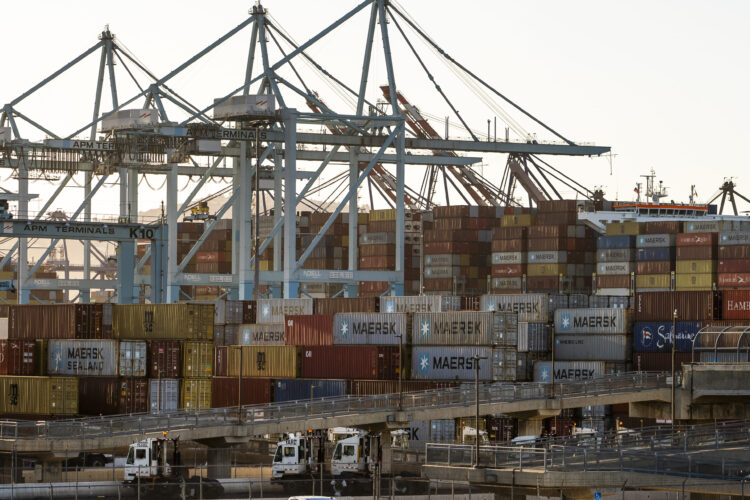Container shipping company Maersk, which previously announced it was suspending transit through the Red Sea due to Houthi attacks, has extended that suspension “for the foreseeable future.” It is also warning its customers to get ready for major disruptions.
“The situation is constantly evolving and remains highly volatile, and all available intelligence at hand confirms that the security risk continues to be at a significantly elevated level,” Maersk, one of the largest companies in the world, said in a statement published Friday. “While we continue to hope for a sustainable resolution in the near future and do all we can to contribute towards it, we do encourage customers to prepare for complications in the area to persist and for there to be significant disruption to the global network.”
Shipping giants all over the world, including Mediterranean Shipping Co. (MSC), Taiwan’s Evergreen, BP, and Hapag-Lloyd AG, have also suspended Red Sea transit. They are instead opting for the costly and time-consuming trip around Africa’s Cape of Good Hope, which adds around 1-2 weeks to voyages and requires $1 million on average in extra fuel per ship as well as higher crew numbers.
Learn the benefits of becoming a Valuetainment Member and subscribe today!
This has already caused delivery delays, affecting companies such as Walmart, Amazon, and IKEA. The Suez Canal, which cuts through Egypt from the Mediterranean into the Red Sea, processes about a third of global cargo, from furniture to electronics.
In the week of December 11th, 2023, freight rates were reportedly around $1,900 for 20-foot containers and $2,400 for 40-foot containers. By the week of December 21st, rates for 40-foot containers from Shanghai to the UK hit $10,000, according to quotes from logistics managers reported by CNBC.
In March 2021, the Evergreen ship that got stuck in the Suez caused container rates to double from $10,000 up to $20,000 during the six-day disturbance, according to Kari O’Rourke, Logistics Manager of hardscaping supplier Yardco Inc. They had hit $20,000 in the thick of the COVID pandemic, but had come back down to $10,000 in the weeks leading up to the Evergreen crisis.
Some 389 container vessels holding 5.4 million twenty-foot containers are being diverted, according to Director of Sales Jordan Hibbett of Steam Logistics, a Tennessee-based shipping analyst firm.
“The immediate effect of carriers diverting away from the Red Sea is increased transit time,” Hibbett told Valuetainment via email. “It takes an additional 1-2 weeks for vessels to get to US East Coast ports via Cape of Good Hope vs the Suez Canal. Along with the increased transit time, it is 1-2 weeks of additional fuel the vessels have to use.”
In addition to problems in the Red Sea, the Panama Canal is also experiencing an immense bottleneck due to an unusual drought. This has caused it to operate at 60% of its regular capacity, permitting only 22 vessels per day as opposed to the typical 36-40, according to Steam Logistics.
Hibbett went on:
“If the situation with both canals continues to get worse the ocean carriers will continue to raise rates and keep the cost of ocean shipping up. […] We’ve already seen ocean carriers fully take advantage of this ‘perfect storm’ as they’ve raised ocean rates between $800 – $1200 on January 1st and are planning to increase rates another $1000 on January 15th. […] If rates keep going up there comes a point when shippers won’t be able to absorb the cost and it will eventually be passed down to the US consumer as we saw a few years ago.
The first thing some people may think about when they see what’s going on with the Red Sea is if they’re going to deal with goods shortages again. However, factories are still working, containers are still getting loaded, and the vessels are still moving. It’s taking vessels 1-2 weeks longer to get to USEC ports but trade lanes such as Shanghai – Los Angeles are not seeing increased transits, yet… If the disruptions continue, eventually you will see delays with USWC ports with more vessels taking longer to complete their service routes and get back to Asia pushing sailing schedules back.”
The U.S. has assembled a 10-nation naval fleet to neutralize the Houthi threat, but the conflict appears far from over.
As Valuetainment previously reported, Houthi militants have been attacking and hijacking ships traveling to and from the Suez Canal off the coast of Yemen in the Red Sea. Their stated reason is to retaliate against the United States and its global allies for supporting Israel in its war against Islamist terrorist group Hamas. The Houthis even attacked an American warship in early December.
Shane Devine is a writer covering politics, economics, and culture for Valuetainment. Follow Shane on X (Twitter).



















Add comment